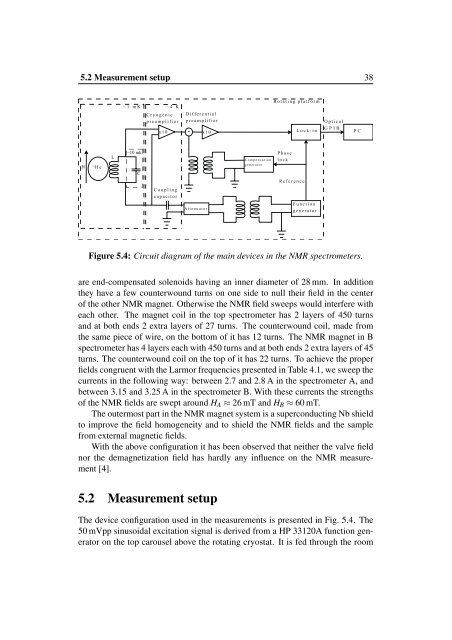NMR Techniques at Liquid Helium Temperatures - Low ...
NMR Techniques at Liquid Helium Temperatures - Low ...
NMR Techniques at Liquid Helium Temperatures - Low ...
Create successful ePaper yourself
Turn your PDF publications into a flip-book with our unique Google optimized e-Paper software.
5.2 Measurement setup 38<br />
H<br />
3 He<br />
L<br />
~1 mK<br />
~10 mk<br />
C<br />
x10<br />
~4 K<br />
Cryogenic<br />
preamplifier<br />
Coupling<br />
capacitor<br />
Differential<br />
preamplifier<br />
-<br />
x10<br />
Attenu<strong>at</strong>or<br />
Compens<strong>at</strong>ion<br />
gener<strong>at</strong>or<br />
Rot<strong>at</strong>ing pl<strong>at</strong>form<br />
Phase<br />
lock<br />
Reference<br />
Lock-in<br />
Function<br />
gener<strong>at</strong>or<br />
Optical<br />
GPIB<br />
Figure 5.4: Circuit diagram of the main devices in the <strong>NMR</strong> spectrometers.<br />
are end-compens<strong>at</strong>ed solenoids having an inner diameter of 28 mm. In addition<br />
they have a few counterwound turns on one side to null their field in the center<br />
of the other <strong>NMR</strong> magnet. Otherwise the <strong>NMR</strong> field sweeps would interfere with<br />
each other. The magnet coil in the top spectrometer has 2 layers of 450 turns<br />
and <strong>at</strong> both ends 2 extra layers of 27 turns. The counterwound coil, made from<br />
the same piece of wire, on the bottom of it has 12 turns. The <strong>NMR</strong> magnet in B<br />
spectrometer has 4 layers each with 450 turns and <strong>at</strong> both ends 2 extra layers of 45<br />
turns. The counterwound coil on the top of it has 22 turns. To achieve the proper<br />
fields congruent with the Larmor frequencies presented in Table 4.1, we sweep the<br />
currents in the following way: between 2.7 and 2.8 A in the spectrometer A, and<br />
between 3.15 and 3.25 A in the spectrometer B. With these currents the strengths<br />
of the <strong>NMR</strong> fields are swept around HA ≈ 26 mT and HB ≈ 60 mT.<br />
The outermost part in the <strong>NMR</strong> magnet system is a superconducting Nb shield<br />
to improve the field homogeneity and to shield the <strong>NMR</strong> fields and the sample<br />
from external magnetic fields.<br />
With the above configur<strong>at</strong>ion it has been observed th<strong>at</strong> neither the valve field<br />
nor the demagnetiz<strong>at</strong>ion field has hardly any influence on the <strong>NMR</strong> measurement<br />
[4].<br />
5.2 Measurement setup<br />
The device configur<strong>at</strong>ion used in the measurements is presented in Fig. 5.4. The<br />
50 mVpp sinusoidal excit<strong>at</strong>ion signal is derived from a HP 33120A function gener<strong>at</strong>or<br />
on the top carousel above the rot<strong>at</strong>ing cryost<strong>at</strong>. It is fed through the room<br />
PC

















